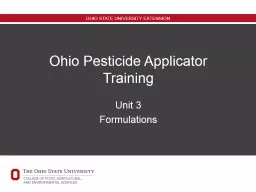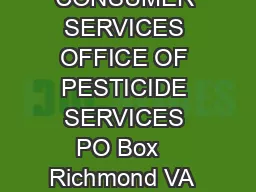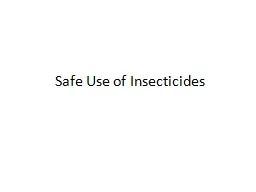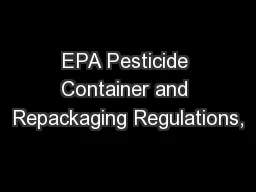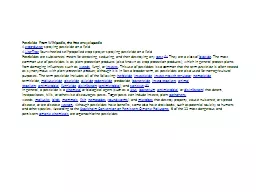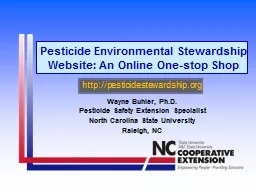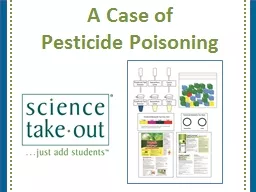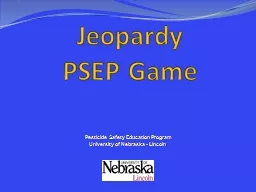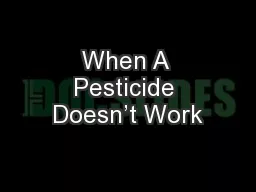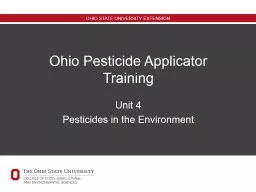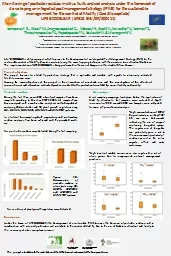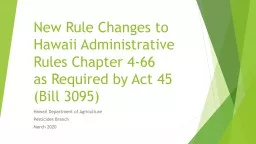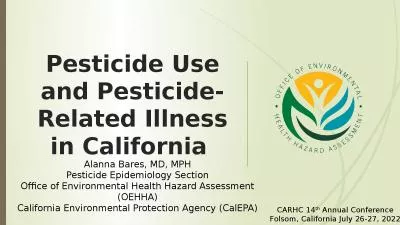PPT-Ohio Pesticide Applicator Training
Author : liane-varnes | Published Date : 2018-11-01
Unit 3 Formulations What is a Formulation All the Ingredients in a pesticide product The active ingredients or control chemical The inert inactive ingredients Usually
Presentation Embed Code
Download Presentation
Download Presentation The PPT/PDF document "Ohio Pesticide Applicator Training" is the property of its rightful owner. Permission is granted to download and print the materials on this website for personal, non-commercial use only, and to display it on your personal computer provided you do not modify the materials and that you retain all copyright notices contained in the materials. By downloading content from our website, you accept the terms of this agreement.
Ohio Pesticide Applicator Training: Transcript
Unit 3 Formulations What is a Formulation All the Ingredients in a pesticide product The active ingredients or control chemical The inert inactive ingredients Usually formulations are diluted in water a petroleumbased solvent or other diluents. Formulating a pesticide involves processing it to improve its storage handling safety application or effectiveness See the text box on Some Formulations What makes up a formulation The pesticide formulation is a mixture of active and other ingredien vdacsvirginiagov COMMERCIAL PESTICIDE APPLICATOR CERTIFICATION APPLICATION In accordance with the Virginia Pesticide Control Act and regu lations adopted there under application is hereby made for CERTIFICATION as a Commercia l Applicator in Virginia Learning Objectives. 1. Describe what information is located on an insecticide label.. 2. Distinguish how insecticide toxicity is measured.. 3. Describe what certifications are required for pesticide applicators.. Flow Chart 1: Is this container a service container or a. Is the container going to be filled as a service container (when an applicator transfers pesticide into a container for the purposes of . that applicator. Wikipedia, the free encyclopedia. A . crop-duster. spraying pesticide on a field. A . Lite-Trac. four-wheeled self-propelled crop sprayer spraying pesticide on a field. Pesticides. are substances meant for attracting, seducing, and then destroying any . Wayne Buhler, Ph.D.. Pesticide Safety Extension Specialist. North Carolina State University. Raleigh, NC. http://pesticidestewardship.org. “…emblematic”. Website Topics. Calibration. Container Management. . Please complete the “Participant Card”. 2. Put your student hat on. Experience the kit. Put your teacher hat on. Envision classroom use. Curriculum integration. Support for students. 3. . A Case of Pesticide Poisoning. University of Nebraska - Lincoln. Notice to PSEP Educators. Keep this Slide Number 2 as “hidden” so that it will not be seen during your presentation.. After each question is addressed with your audience during the Jeopardy Game, click on the “tree” graphic in the lower right hand corner in order to return back to the Jeopardy game board rather than using the typical “slide advance” method.. Wayne Buhler . and . Mary Christie. , NC State University, and . Mark . Shour. , Iowa State university. (. Based on a fact sheet by . Fred . Fishel. , Univ. of Florida). Pesticides…. …important tools used to manage pests. Unit 4. Pesticides in the Environment. Explain the Meaning of the Word “ENVIRONMENT”. EVERYTHING AROUND US. NATURAL ELEMENTS. MAN . MADE COMPONENTS. INDOORS . AND OUTDOORS. AIR. SOIL. WATER. PLANTS. developing an integrated pest management strategy (IPMS) for the sustainable management for the control of Med fly . (. Ceratitis. . capitata. ). LIFE BIODELEAR (LIFE13 ENV/GR/000414). . Bempelou. as Required by Act 45 . (Bill 3095). Hawaii Department of Agriculture. Pesticides Branch. March 2020. New Laws and Rules. ACT 045. , Senate Bill 3095 amends Hawaii Revised Statutes (HRS). Approved. amendments to Hawaii Administrative Rules Chapter 4-66 (. Alanna Bares, MD, MPH. Pesticide Epidemiology Section. Office of Environmental Health Hazard Assessment (OEHHA). California Environmental Protection Agency (CalEPA). CARHC 14. th. Annual Conference. Dicamba Ban HB4363. Amends the Illinois Pesticide Act. Provides that on and after January 1, 2023, no person or entity may use any product containing dicamba for agricultural, commercial, or residential use within the State. Provides that the amendatory provisions do not apply to the use of dicamba that is purchased before the amendatory Act's effective date. Defines "dicamba". .
Download Document
Here is the link to download the presentation.
"Ohio Pesticide Applicator Training"The content belongs to its owner. You may download and print it for personal use, without modification, and keep all copyright notices. By downloading, you agree to these terms.
Related Documents

